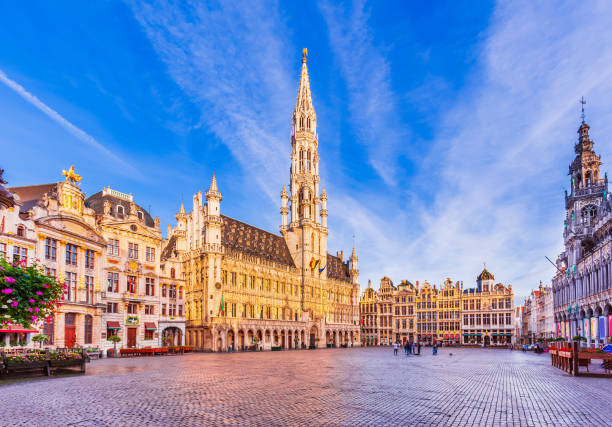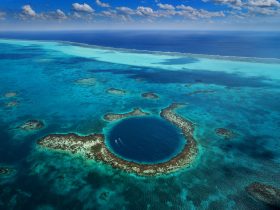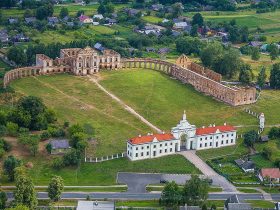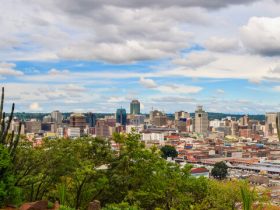Brussels, the cosmopolitan capital of Belgium and de facto capital of the European Union, blends historic charm with modern internationalism. Known for its medieval architecture, famous chocolates, rich cultural heritage, and political significance, Brussels offers visitors a captivating journey through both past and present. Whether you’re drawn to its Gothic cathedrals, buzzing cafés, or iconic Atomium, Brussels is a city that surprises and delights at every turn.
📊 Key Facts About Brussels
| Feature | Detail & Explanation |
|---|---|
| Official Languages | French and Dutch – Both are used in administration and education. |
| Population | Approximately 1.2 million – A diverse, multicultural population. |
| Area | 161 km² – A compact city with distinct neighborhoods. |
| Country | Belgium – Brussels is the capital. |
| Continent | Europe – Centrally located in Western Europe. |
| Local Time | Central European Time (CET, UTC+1) |
| Currency | Euro (€) – Widely accepted across the EU. |
| Plug Type | Type C and E – Standard voltage is 230V, frequency 50Hz. |
| Avg. Annual Temperature | 10.5°C (50.9°F) – Mild oceanic climate. |
| Climate | Oceanic – Cool winters and mild summers with frequent rain. |
| Vegetation | Mixed deciduous forest – Common in parks and green areas. |
| Main Industries | Politics, services, tourism, and finance. |
| Country Code | +32 – International dialing code for Belgium. |
| City Phone Code | 2 – Brussels’ area code. |
🏰 Top Tourist Attractions in Brussels
- Grand Place: A UNESCO World Heritage site, known for its ornate guildhalls and vibrant flower carpet in August.
- Atomium: A futuristic monument and museum shaped like a unit cell of an iron crystal.
- Manneken Pis: The cheeky little statue is a city icon with a rotating wardrobe of costumes.
- Royal Palace of Brussels: Official palace of the Belgian King, open for visits in summer.
- Parc du Cinquantenaire: A majestic park with arcades, museums, and lush gardens.
✈️ How to Get to Brussels
Brussels is well connected by air, rail, and road:
- By Air: Brussels Airport (Zaventem) is 12 km from the city center, connected via train and bus.
- By Train: Thalys, Eurostar, and ICE trains connect Brussels with Paris, London, Amsterdam, and Cologne.
- By Car: European highways E40, E19, and E411 pass through Brussels.
🚇 Best Transportation Tips
- Use the STIB-MIVB metro, bus, and tram network for efficient local travel.
- Purchase a Brupass or day ticket for unlimited access.
- Renting bikes or e-scooters is eco-friendly and a great way to explore parks.
- Brussels Card offers discounts on public transport and museums.
🏨 Where to Stay in Brussels
💰 Cheapest Hotels
- Meininger Hotel Brussels City Center – From €35/night, hostel-style rooms with modern design.
- Sleep Well Youth Hostel – Clean, central, eco-certified; from €30/night.
🌟 Best Hotels
- Hotel Amigo – Luxury and history blended near Grand Place; from €250/night.
- Steigenberger Wiltcher’s – 5-star experience on Avenue Louise; from €280/night.
🍽️ Food Recommendations
- Moules-frites: Mussels served with fries – a national favorite.
- Belgian Waffles: Crisp and sweet, perfect with chocolate or fruit.
- Stoofvlees: Flemish beef stew cooked in beer.
☕ Best Cafés and Restaurants
- Maison Dandoy: Traditional waffles and speculoos cookies near the Grand Place.
- Noordzee Mer du Nord: Seafood kiosk with standing tables and fast service.
- La Roue d’Or: Art Nouveau interior, classic Belgian cuisine.
📜 A Brief History of Brussels
Brussels began as a small fortress in the 10th century and grew into a major European hub. It was the capital of the Duchy of Brabant, witnessed the rise of Belgian independence in 1830, and eventually became the administrative heart of the European Union.
🏘️ Districts, Neighborhoods and Villages
- Ixelles: Trendy, multicultural, and home to many expats.
- Etterbeek: Close to EU buildings, family-friendly.
- Sablon: Antique shops and gourmet chocolates.
- Laeken: Royal Palace and Atomium.
🌍 Important Geographic Features
- Senne River: Once flowed openly through Brussels, now largely underground.
- Sonian Forest: A UNESCO-listed beech forest south of the city.
- Canal of Brussels: A scenic waterway with walking and cycling paths.
🎭 Famous Residents
- René Magritte: Surrealist painter with a museum in his honor.
- Audrey Hepburn: Born in Brussels in 1929.
- Jacques Brel: Iconic Belgian singer-songwriter.
🗺️ Neighboring Cities and Countries
- Antwerp: Fashion and diamond capital, 45 minutes by train.
- Ghent and Bruges: Medieval towns perfect for day trips.
- France, Netherlands, Germany: Easy access via high-speed trains.
💡 Insider Tips
- Book EU Parliament tours in advance for free entry.
- Visit in spring or fall to avoid tourist crowds and enjoy mild weather.
- Check out local flea markets in Marolles for vintage finds.
- Look up – many buildings feature stunning Art Nouveau façades.
❓ Frequently Asked Questions
- Is English widely spoken in Brussels?
Yes, most people in tourism and business speak English fluently. - When is the best time to visit Brussels?
Spring (April–June) and fall (September–October) offer great weather and fewer crowds. - Is Brussels expensive?
Moderately so, but many free or low-cost attractions are available. - What’s the tipping culture like?
Service is included, but rounding up is appreciated. - How many days do you need in Brussels?
2–3 days is ideal for major highlights, or longer for nearby cities. - Can I drink tap water in Brussels?
Yes, tap water is safe and clean. - Do I need a visa?
EU citizens do not. Others may need a Schengen visa depending on nationality. - Is public transport safe?
Yes, especially during the day. Exercise normal caution at night.
🧳 Suggested Itinerary for Brussels
Day 1: The Historic Heart
- Morning: Start at Grand Place and explore surrounding guild houses.
- Midday: Visit Manneken Pis and stop for a waffle at Maison Dandoy.
- Afternoon: Tour the City Museum and relax at Mont des Arts.
- Evening: Dine at La Roue d’Or and enjoy Belgian beer at Delirium Café.
Day 2: Modern Brussels & the EU
- Morning: Visit the Atomium and Mini-Europe.
- Midday: Lunch at Noordzee followed by a visit to the Magritte Museum.
- Afternoon: Explore the European Quarter and Parc Leopold.
- Evening: Try a bistro in Ixelles like Le Chou de Bruxelles.
Day 3: Off the Beaten Path
- Morning: Stroll through the Marolles Flea Market and admire Art Nouveau buildings.
- Midday: Picnic at Parc du Cinquantenaire or in the Sonian Forest.
- Afternoon: Visit the Royal Greenhouses of Laeken (seasonal).
- Evening: Wind down at a jazz café or enjoy local theater in French or Dutch.
🎟️ Free and Cheap Things to Do in Brussels
- Grand Place: Always free to enjoy its stunning beauty.
- Comic Strip Route: Hunt murals of Tintin and other characters across the city.
- Royal Palace: Free entry during summer openings.
- Free Museum Days: Many museums are free on the first Wednesday or Sunday of the month.
🎉 Seasonal Events and Festivals
- Ommegang (July): Medieval pageant at Grand Place.
- Flower Carpet (August, every 2 years): A 77m-long floral tapestry fills Grand Place.
- Brussels Summer Festival: Outdoor music and cultural acts.
- Plaisirs d’Hiver (Winter Wonders): A magical Christmas market and ice rink experience.
👮 Safety and Traveler Tips
- Pickpocketing: Common in touristy areas — keep bags zipped and valuables hidden.
- Tap water: Safe to drink, no need for bottled water.
- Transport at night: STIB has limited night buses; taxis or ride-sharing apps are reliable.
- Weather: Always carry a compact umbrella — sudden showers are common!
📱 Connectivity and SIM Cards
- Free Wi-Fi: Available at Brussels Airport, many cafés, and public libraries.
- SIM cards: Proximus, Orange, and Base offer tourist packages with good data plans.
🛍️ Shopping in Brussels
- Galeries Royales Saint-Hubert: Elegant glass-roofed arcade with boutiques and chocolatiers.
- Avenue Louise: Designer fashion and luxury goods.
- Rue Neuve: Brussels’ main shopping street for global brands.
- Place du Jeu de Balle: Daily flea market with unique vintage finds.
🧑🎨 Local Culture and Etiquette
- Belgians are reserved but polite — a simple “Bonjour” or “Goedendag” goes a long way.
- Punctuality is appreciated, especially in business settings.
- Tipping isn’t mandatory but rounding up the bill is common.
❓ Frequently Asked Questions (Extended)
- Are museums in Brussels child-friendly?
Yes, several museums like Train World and Museum of Natural Sciences cater to kids. - Can I use my credit card everywhere?
Mostly yes, but carry some euros for markets and smaller vendors. - Which language should I use?
French is most commonly spoken, but English is widely understood in the city center.







Leave a Review